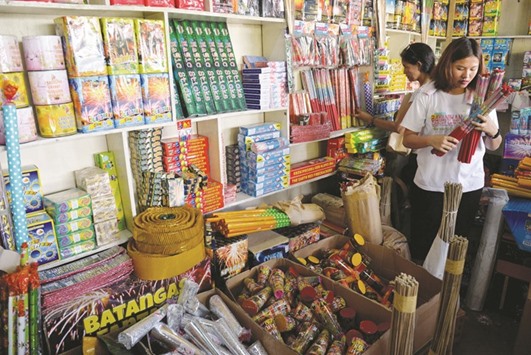Firecracker-related injuries rose to 141 cases hours before the New Year revelry, including another case of firecracker ingestion.
Still, the figure was 73 cases down from last year, and 79 cases lower compared with the five-year average number of injuries, the Department of Health (DOH) said.
A four-year-old boy from Navotas City was tricked by his brother into ingesting a firecracker, “pop pop.” He was treated at Tondo Medical Centre.
More than half of the reported injuries were in the National Capital Region (NCR), at 73 cases. Manila had the most number of cases at 31. Quezon City had 21 and Mandaluyong, five.
Most injuries were caused by illegal firecrackers, at 108 cases, the DOH noted.
The banned “piccolo” accounted for the most number of injuries at 78. It was followed by “boga” with 14, and whistle bomb and kwitis with six each.Moreover, 62 of the injured firecracker users were aged 15 years old and below.
Hands were the most injured parts, accounting for 90 cases, followed by the eyes with 28 cases.
The city government of Manila expects fewer firecracker-related injuries this New Year, Mayor Joseph Estrada said.
In the last three years, the city has seen a decreasing trend in firecracker-related incidents because of a campaign against illegal firecrackers and pyrotechnics, he said.
The Manila Health Department said there were about 700 firecracker and burn injuries tallied in 2013, 500 in 2014 and 300 in 2015.
“We have been reiterating the ill effects of using firecrackers every year. We visited schools at the village, to inform them that these firecrackers, if not handled properly, can lead to serious injuries, death through fire,” the mayor said.Manila health chief Dr Benjamin Yson said most firecracker-related injuries in the city involved skin burns and minor wounds.
On standby for the New Year revelry are six city-owned hospitals, which have stockpiled medicines and first-aid supplies for firecracker blast victims.
“They’re on full alert, to address blast injuries; possible shooting victims, stray bullets or direct altercations; stabbing victims. They’re ready since December 24, up to January 1,” Yson said.
Manila’s six public hospitals—Santa Ana Hospital, Ospital ng Tondo, Ospital ng Sampaloc, Ospital ng Maynila Medical Centre, Gat Andres Bonifacio Memorial Medical Centre and Justice Jose Abad Santos General Hospital—are manned by about 600 doctors.
The number of stray-bullet and indiscriminate firing incidents monitored by the police during the holidays is also down significantly from recent years.
Figures from the Philippine National Police’s Directorate for Investigative and Detective Management showed that from December 16 to December 29, police recorded a total of eight incidents of stray-bullet injuries.
This was lower compared with 55 incidents recorded in the same period last year, 68 incidents in 2014, and 31 incidents in 2013.
Metro Manila had the highest number of stray-bullet incidents this year, with a total of three incidents recorded from December 16 up to December 29.
Police recorded 16 such incidents in Metro Manila in 2015, 16 in 2014 and nine in 2013. Central Visayas recorded three incidents during the same period, while one incident was recorded each in the Cordilleras and Soccskargen.
Police also recorded 10 incidents of indiscriminate firing or illegal discharge of firearms, compared with 11 in 2015, 40 in 2014, and 32 in 2013.

Firecrackers for sale are pictured in a store during New Year’s Eve in Bocaue, Bulacan province, north of Manila, yesterday.
